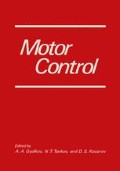Abstract
The alpha-motoneurones constitute an essential element in the system of motor control. The advance of neurophysiology led to the accumulation of abundant information about their properties and functions. There is a certain lack, however, in studies related to the problem of just how the alpha-motoneurones are operating under conditions of natural motor activity, under normal physiological conditions, and particularly in man, where we have an extremely high development of the system of motor control.
Access this chapter
Tax calculation will be finalised at checkout
Purchases are for personal use only
Preview
Unable to display preview. Download preview PDF.
Reference
BASMAJIAN J.N. (1963). Conscious control of single nerve cells. New Scientist, 20: 662–664.
BURKE R.E. (1967). Motor unit types of cat triceps surae muscle. J.Physiol.(Lond.), 193: 141–160.
BURKE R. (1968a). Group ia synaptic input to fast and slow twitch motor units of cat triceps surae. J.Physiol. (Lond.), 196: 605–630.
BURKE R.E. (1968b). Firing patterns of gastrochemius motor units in the decerebrate cat. J.Physio1.(Lond.). 196: 631–655.
COERS C. and WOOLF A.L. (1957). The innervation of muscle. pp. 6–7, pp 14–20, Oxford, Blackwell.
ECCLES J.C., ECCLES R.M., IGGO A. and ITO M. (1961).Distribution of recurrent inhibition among motoneurones. J.Physiol.(Lond.), 159: 479–499.
ECCLES J.C., ECCLES R.M. and LUNDBERG A. (1957a). Durations of afterhyperpolarization of motoneurones supplying fast and slow muscles. Nature (Lond.), 179: 866–868.
ECCLES J.C., EECCLES R.M. and LUNDBERG A. (1957b). The convergence of monosynaptic excitatory afferents onto many different species of alpha motoneurones. J.Phys- io1.(Lond.), 137: 22–50.
ECCLES J.C., ECCLES R.M. and LUNDBERG A. (1958). The action potentials of the alpha-motoneurones supplying fast and slow muscles. J.Physiol.(Lond.), 142: 275–291.
GRANIT R., HENATSCH H.-D., and STEG G. (1956a). Differentiation of tonic from phasic extensor motoneurones by post-tetanic potentiation. J.Physiol.(Lond.), 133: 12–13.
GRANIT R., HENATSCH H.-D. and STEG G. (1956b). Tonic and phasic ventral horn cells differentiated by post- tetanic potentiation in cat extensors. Acta physiol. scand., 37: 1 14–126.
GRANIT R., KERNELL D. and LAMARRE Y. (1966). Algebraical summation in synaptic activation of motoneurones firing within the “primary range” to injected currents. J.Physiol.(Lond.), 187: 379–399.
GRANIT R., PASCOE J.E. and STEG G. (1957). The behaviour of tonic α and γ motoneurones during stimulation of recurrent collaterals. J.Physiol.(Lond.), 138: 381–400.
GRANIT R. and RUTLEDGE L.T. (1960). Surplus excitation in reflex action of motoneurones as measured by recurrent inhibition. J.Physiol.(Lond.), 154: 288–307.
GRIMBY L. and HANNERZ J. (1968). Recruitment order of motor units on voluntary contraction: changes induced by proprioceptive aferent activity. J.Neurol.Neurosurg. Psychiat., 31: 565–573.
GURFINKEL V.S., MIRSKYI M.L., Tarko A.M and Surgulad- ZE T.D. (1972). The work of the motor units in man upon initiation of the muscle tension, (in Russian). Biofizika, 17: 303–310.
GYDIKOV A. and KOSAROV D. (1972a). Studies on the activity of the alpha-motoneurones in man by means of new EMG methods. In: Neurophysiology in Man. Proceedings of the International Symposium on Neurophysiology in Man, Paris, July 20–22,1971. Amsterdam, Excerpta Medica.
GYDIKOV A. and KOSAROV D. (1972b). Extraterritorial potential field of impulses from separate motor units in man’s muscles. Electromyography, 12: 283–305.
GYDIKOV A., KOSAROV D. and TANKOV N. (1972). Studying the alpha-motoneurone activity by investigating motor units of various sizes. Electromyography, 12: 99–117.
HARRISON V.F. and MORTENSEN O.A. (1960). Identificationand voluntary activation of low-threshold motor units. Anat.Rec., 136: 207.
HENNEMAN E. (1957). Relation between size of neurones and their susceptibility to discharge. Science. 126, (3287): 1345–1346.
HENNEMAN E., SOMJEN G. and CARPENTER D.O. (1965a). Functional significance of cell size in spinal motoneurones. 3.Neurophysiol., 28: 560–596.
HENNEMAN E., SOMJEN G. and CARPENTER D.O. (1965). Excitability and inhibitability of motoneurones of different sizes. J.Neurophysiol, 28: 597–620.
KERNELL D. (1965). The limits of firing frequency in cat lumbosacral motoneurones possessing different time course of afterhyperpolarization. Acta physiol. scand., 65: 87–100.
PERSON R.S. (1972). Motoneurone’s pool and motor control, p.4. In: IV International Biophysics Congress. Abstracts of contributed papers, Moscow.
STEG G. (1962). The function of muscle spindles in spasticity and rigidity. Acta neurol.scand. 38: 53–59.
STEG G. (1964). Efferent muscle innervation and rigidity. Acta physiol.scand., 61, suppl.225.
TQRIZANE T, and SHIMAZIJ H. (1964). Functional differentiation on human skeletal muscle. (Corticalization and spinalization of movement), Springfield, III Charles C.Thomas.
Author information
Authors and Affiliations
Editor information
Editors and Affiliations
Rights and permissions
Copyright information
© 1973 Plenum Press, New York
About this chapter
Cite this chapter
Gydikov, A., Kosarov, D. (1973). Physiological Characteristics of the Tonic and Phasic Motor Units in Human Muscles. In: Gydikov, A.A., Tankov, N.T., Kosarov, D.S. (eds) Motor Control. Springer, Boston, MA. https://doi.org/10.1007/978-1-4613-4502-2_6
Download citation
DOI: https://doi.org/10.1007/978-1-4613-4502-2_6
Publisher Name: Springer, Boston, MA
Print ISBN: 978-1-4613-4504-6
Online ISBN: 978-1-4613-4502-2
eBook Packages: Springer Book Archive

